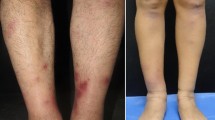Abstract
Anti-inflammatory activity of griseofulvin has been investigated in comparison with indomethacin and flufenamic acid. In vitro, griseofulvin has been proved the most effective of these agents in suppressing the contractions of smooth muscle preparations induced by a variety of proposed mediators of inflammation, i.e. histamine, 5-hydroxytryptamine, bradykinin and prostaglandin E2. In vivo, griseofulvin was unable to modify dextran oedema but suppressed carrageenin oedema, although its activity was poor when compared to that exhibited by indomethacin and flufenamic acid. When tested in rat pleurisy induced by dextran or homologous serum griseofulvin was able to prevent polymorph migration into the pleural space while mononuclears remained virtually unaffected. In contrast indomethacin and flufenamic acid mainly suppressed mononuclear migration while polymorphs resulted only slightly affected. Similar results have been exhibited by the drugs when tested on mononuclear turnover in pleural cavities from normal rats. Results are discussed in the light of the clinically established ability of griseofulvin to prevent cutaneous inflammatory reactions as well as of its effectiveness in the treatment of several polyarthritic syndromes.
Similar content being viewed by others
References
A.J. Anderson, W.E. Brocklehurst andA.L. Willis,Evidence for the Role of Lysosomes in the Formation of Prostaglandins during Carrageenin Induced Inflammation in the Rat, Pharmacol. Res. Com.3, 13–19 (1971).
C. Bedford, K.J. Child andE.G. Tomich,Spectrophotofluorometric Assay of Griseofulvin, Nature184, 364–365 (1959).
H. Blank, J.G. Smith, Jr., F.J. Roth, Jr. andN. Zajas,Griseofulvin for the Systemic Treatment of Dermatomycoses, J. Am. Med. Ass.171, 2168–2173 (1959).
T. Cochrane andA. Tullet,Griseofulvin Treatment of Acute Cattle Ringworm Infections in Man, Brit. Med. J.2, 286–287 (1959).
A. Cohen, J. Goldmann, R. Daniels andW. Kanenson,Treatment of Shoulder-Hand Syndrome with Griseofulvin. J. Am. Med. Ass.173, 542–543 (1960).
W.A. Creasey, K.G. Bensch andS.E. Malawista,Colchicine, Vinblastine and Griseofulvin, Pharmacological Studies with Human Leukocytes, Biochem. Pharmacol.20, 1579–1588 (1971).
P.F. D'Arcy, E.M. Howard, P.W. Muggleton andS.B. Townsend,The Anti-Inflammatory Action of Griseofulvin in Experimental, Animals. J. Pharm. Pharmacol.12, 658–665 (1960).
M.D. Rosa,Biological Properties of Carrageenan, J. Pharm. Pharmacol.24, 89–102 (1972).
M. Di Rosa, J.P. Giroud andD.A. Willoughby,Studies of the Mediators of the Acute Inflammatory Response Induced in Rats in Different Sites by Carrageenin and Turpentine, J. Path.104, 15–29 (1971).
M. Di Rosa, J.M. Papadimitriou andD.A. Willoughby,A Histopathological and Pharmacological Analysis of the Mode of Action of Non-Steroidal Anti-Inflammatory Drugs, J. Path.105, 239–256 (1971).
M. Di Rosa, L. Sorrentino andL. Parente,Non-Steroidal Anti-Inflammatory Drugs and Leucocyte Emigration, J. Pharm. Pharmacol.24, 275–277 (1972).
M. Di Rosa andD.A. Willoughby,Screens for Anti-Inflammatory Drugs, J. Pharm. Pharmacol.23, 297–298 (1971).
J.C. Gentles,Experimental Ringworm in Guinea Pig: Oral Treatment with Griseofulvin, Nature182, 476–477 (1958).
M. Giordano,Griseofulvin for Scleroderma, Lancet2, 260 (1967).
R.J. Gryglewski, B. Panczenko, Z. Gorka, A. Chytkowski andA. Zmuda,Anti-Bradykinin Activity of Flufenamic Acid. Diss. Pharm. Pharmacol. (Poland)21, 1–14 (1969).
J.V. Hurley, G.B. Ryan andA. Friedman,The Mononuclear Response to Intrapleural Infection in the Rat, J. Path.91, 575–587 (1966).
J.T. Litchfield, andF. Wilcoxon,A Simplified Method of Evaluating Dose-Effect Experiments, J. Pharmacol.99, 96–113 (1949).
S.E. Malawista,Colchicine: A Common Mechanism for Its Anti-Inflammatory and Anti-Mitotic Effects, Arthritis Rheum.11, 191–197 (1968).
B.J. Northover,Mechanism of the Inhibitory Action of Indomethacin on Smooth Muscle, Br. J. Pharmacol.41, 540–551 (1971).
A.E. Oxford, H. Raistrick andP. Simonart,studies in the Biochemistry of Microorganisms. IX. Griseofulvin C 17 H 17 O 6 Cl, a Metabolic Product of Penicillium Griseofulvin Dierck, Biochem. J.33, 240–248 (1939).
G.E. Paget andA.L. Walpole,Some Cytological Effects of Griseofulvin, Nature182, 1320–1321 (1958).
J.R. Parrat andG.B. West,Inhibition by Various Substances of Oedema Formation in the Hind-Paw of the Rat Induced by 5-Hydroxytryptamine, Histamine, Dextran, Egg White and Compound 48/80, Br. J. Pharmacol.13, 65–70 (1958).
A. Ravina,Griseofulvine. Traitment du syndrome épaule-main, L'année thérapeutique32, 133–135 (1961).
H. Serre andL. Simon,Action thérapeutique inattendue en rhumatologie d'un antibiotique antifongique: la griseofulvine, Press. Med.70, 2263–2264 (1962).
L. Sorrentino, F. Capasso andM. Di Rosa,Indomethacin and Prostaglandins, Eur. J. Pharmacol.17, 306–308 (1972).
D.I. Williams, R.H. Marten andJ. Sarkany,Oral Treatment of Ring-Worm with Griseofulvin, Lancet2, 1212–1213 (1958).
D.A. Willoughby andM. Di Rosa,A Unifying Concept for Inflammation: A New Appraisal of Some Old Mediators, Immunopathology of Inflammation (Eds. B.K. Forscher and J.C. Hoock; Excerpta Medica. Amsterdam, 1971), pp. 28–38.
C.A. Winter, E.A. Risley andG.W. Nuss,Anti-Inflammatory and Antipyretic Activities of Indomethacin, 1-(p-Chlorobenzoyl)-5-methoxy-2-methylindole-3-acetic acid, J. Pharmacol.141, 369–376 (1963).
Author information
Authors and Affiliations
Rights and permissions
About this article
Cite this article
Sorrentino, L., Capasso, F. & Di Rosa, M. Anti-inflammatory properties of griseofulvin. Agents and Actions 7, 157–162 (1977). https://doi.org/10.1007/BF01964914
Received:
Accepted:
Issue Date:
DOI: https://doi.org/10.1007/BF01964914




